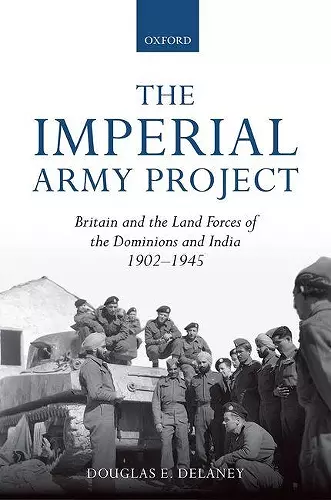The Imperial Army Project
Britain and the Land Forces of the Dominions and India, 1902-1945
Format:Hardback
Publisher:Oxford University Press
Published:11th Jan '18
Currently unavailable, and unfortunately no date known when it will be back
This hardback is available in another edition too:
- Paperback£34.99(9780198845805)

How did British authorities manage to secure the commitment of large dominion and Indian armies that could plan, fight, shoot, communicate, and sustain themselves, in concert with the British Army and with each other, during the era of the two world wars? What did the British want from the dominion and Indian armies and how did they go about trying to get it? Douglas E Delaney seeks to answer these questions to understand whether the imperial army project was successful. Answering these questions requires a long-term perspective -- one that begins with efforts to fix the armies of the British Empire in the aftermath of their desultory performance in South Africa (1899-1903) and follows through to the high point of imperial military cooperation during the Second World War. Based on multi-archival research conducted in six different countries, on four continents, Delaney argues that the military compatibility of the British Empire armies was the product of a deliberate and enduring imperial army project, one that aimed at standardizing and piecing together the armies of the empire, while, at the same time, accommodating the burgeoning autonomy of the dominions and even India. At its core, this book is really about how a military coalition worked.
This work is valuable to academics and graduate students alike who study the British Empire's military effort in the twentieth century. * Brad St. Croix, Canadian Military History *
This is a hugely ambitious and successful book. In explaining how the British imperial military coalitionworked, Delaney alsoexplains how it was that the people of a small island off the north-west coast of Europe were able for so long to defend an empire that spanned the globe. It should be compulsory reading for anyone interested in the history of the British Empire in the era of the two world wars. * David French, author of Raising Churchills Army: the British Army and the War against Germany, 1919-1945. (OUP, 2000) *
How did the Imperial General Staff manage to secure the cooperation of the sometimes fractious and increasingly autonomous Dominions and India in standardizing the ways in which they could operate together in war almost seamlessly? Delaneys beautifully written study is based on extraordinarily thorough research that clearly explains how the Imperial Army Project succeeded in moulding Empire-Commonwealth armies that could and did fight as one through two world wars. * J.L. Granatstein, Author of Canadas Army: Waging War and Keeping the Peace. *
Delaneys depth of knowledge and acute comparative analysis are on full display with The Imperial Army Project.He pivots easily from one national army to another, each with its own peculiarities, and then returns to the British, who tied it all together.This is a masterpiece of scholarship that adds exhaustive archival research to the existing literature and creates something completely new. * Tim Cook, Author of Shock Troops: Canadians Fighting the Great War, 1917-1918 and Fight to the Finish: Canadians in the Second World War, 1944-1945 *
The Imperial Army Project is a masterful study. Douglas E. Delaney skilfully shows how the armies of Britain, Canada, Australia, New Zealand, the Union of South Africa and India spent four decades developing national armies that were compatible across the British Empire. This interoperability allowed for the efficient combination of military forces during the two world wars. Britain did not, and need not, stand alone. The empire stood together. Indeed, it this comparative approach that makes Delaneys a must-read work. * Dr Karl James, Head of the Military History Section, Australian War Memorial *
Douglas Delaney's masterly book shows that the creation of a series of interoperable armies across the British Empire was no accident. Rather it was the result of a highly successful imperial project which contributed significantly to the victories won in 1918 and 1945. This book is an important contribution to both military and imperial history. * Gary Sheffield, Author of The Chief: Douglas Haig and the British Army and Forgotten Victory: The First World War: Myths and Realities *
- Winner of Honourable mention for the 2018 C.P. Stacey Prize, awarded by the Canadian Committee for the History of the Second World War and the Canadian Commission for Military History Shortlisted for the 2018 Templer Medal Book Prize, awarded by the Society for Army Historical Research.
ISBN: 9780198704461
Dimensions: 241mm x 164mm x 28mm
Weight: 734g
374 pages